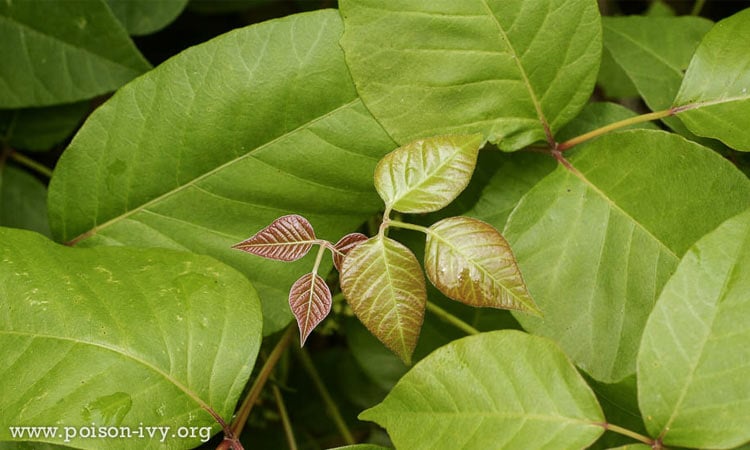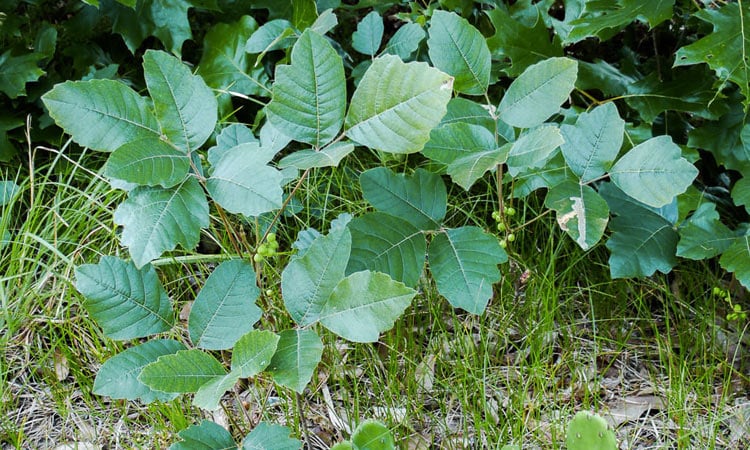“Leaves of three, leave them be.” – A quote from every mom ever.
I’m sure you’ve heard that saying before. My great-grandmother, grandma, and mom have all embedded that into our family’s heads. We grew up in the country, so when we wanted to play, we went outside. When you’re a little kid running around in the woods in your underwear, it’s good to know what Poison Ivy, Poison Oak, and Poison Sumac look like.

Poison Ivy
The easiest way to identify Poison Ivy is by the cluster of three leaves on the end of a (usually reddish) stem. The leaves may have barely ruffled edges or can be completely smooth, but they are always oblong and pointy. The plants grow as a vine up trees or as a stand-alone shrub.
It’s important to be aware of the changing appearance of the plant throughout the year. In the Spring, new leaves have a reddish tint to them as they grow. During the summer they are larger and dark green. In the fall, they are actually beautiful, matching the changing foliage by turning red, yellow, and orange. For a great reference and more detailed photos, check out Poison-Ivy.org.

Poison Oak
Very similar in appearance to Poison Ivy, Poison Oak plants have three leaves at the end of a stem as well (though on rare occasions you might see 5-7). The leaves, however, are more scalloped in appearance than Poison Ivy. The tips are more round, closely resembling those of oak. Stems are always staggered, and never grow side by side.
Another major difference between the two plants is that the berries on Poison Oak, also known as drupes, are fuzzy. Like Poison Ivy, Poison Oak grows as a vine or small to medium-sized shrub. The leaves also change color in the fall.

Poison Sumac
Poison Sumac looks much different than it’s other poisonous friends and it’s usually easy to recognize from a distance. The leaves are round with pointed tips and the stems are a purplish-red. Though green in the Spring and Summer time, the plants turn a red, orange, and yellow in the fall.
Usually found near lower lying wetlands, Poison Sumac plants are rare in mountainous areas. In spring and early summer, they feature small green flowers and drupes, which look like berries. Unlike Poison Ivy and Poison Oak, Poison Sumac does not grow on a vine.
Why It Hurts and What To Do
Upon contact, the rash you develop is thanks to a lovely chemical compound named urushiol. It’s an oily resin that coats the outside of the plant’s leaves, stems, vines, and roots. When you come into contact, the best thing to do is note where and what it came in contact with. Try your best not to spread it to other parts of your body. Wash the affected area with soap and water ASAP.
The blisters and rashes form on your skin because of a complex reaction to your immune system. If you’re sweating, as most hikers and bikers are, the sweat can carry the oil down your body, increasing the affected areas.
The resin loves to hang out on your clothes and pets fur too! I’ve gotten a rash two days after a hike while doing laundry. A lovely little surprise from the woods.

Problems With Lookalikes…
To make identification more difficult, the plants have a number of twins in our region. As a rule of thumb, if you have to question what it is, just avoid it altogether. Recently, I put up a poll on the Blue Ridge Outdoors Instagram account to test some of our follower’s poison ivy knowledge. I showed one picture of poison ivy, and then 5 pictures of lookalike plants from our region. The question was simple for each one: What type of plant is this? Poison Ivy or…

Plant 1: Boston Ivy 81% got it right
An attractive climbing plant, Boston Ivy usually resembles Poison Ivy in it’s younger stages of life. A deciduous woody vine, it is a flowering plant that is a part of the grape family and is closely related to the Virginia Creeper. It’s widely used as an ornamental plant used to cover buildings, fences, and more.

Plant 2: Poison Oak 54% got it right
The leaves of three rule applies to this plant as well. Poison Oak closely resembles Poison Ivy, though it’s leaves are usually not as rounded and have more ruffles on the edges. Regardless of it’s close resemblance, leave it alone.

Plant 3: Virginia Creeper 77% got it right
Like the Boston Ivy, Virginia Creeper is grown as an ornamental plant, used to decorate walls, fences, and other facades. In it’s younger stages, it also can be confused with Poison Ivy. It’s very prominent in our region and looks especially beautiful in the fall!
Increasing the Itch – Study Says Climate Change Brings More Poison Ivy with Greater Potency

Plant 4 Kudzu: 78% got it right
At first glance, Kudzu leaves can be hard to tell apart from Poison Ivy. Extremely common around the Southeast, Kudzu is an invasive species, introduced from Japan in the late 1800s.

Plant 5 Boxelder Maple: 61% got it right
Boxelder Maples are common around our region and while they have 5 leaflets per stem, they are still confused with Poison Ivy due to the three leaves on the very tip of the stem. Though they are rare in the high country, there are five different species that live in the low lying areas of our region.
According to my little Instagram experiment, it seems that most of our followers are knowledgeable in identifying these poisonous plants. That being said, I will leave you with one piece of advice:
If you’re unsure of what it is, just walk the other way.
Do you know of any other look-alikes, have any home remedies, or any other tips on these plants? Let us know on Facebook!
Justin Forrest is an outdoor writer and fly fishing addict based in Asheville, N.C. He posts pictures of cats and fishing on Instagram sometimes.






